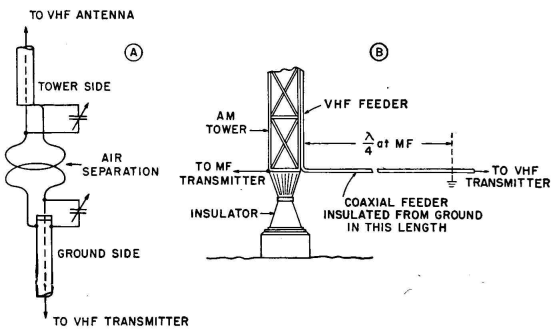|
FM-TV on AM Antennas
Author: Edmund A. Laport
The mounting of an antenna for frequency modulation or television on a medium-frequency tower antenna in such a way as to increase its height or produce the effect of top loading will affect its feed-point impedance.
 |
| FIG. 2.35. Two methods of by-passing tower-base insulator to feed a very-high-frequency antenna on tower. (After Holtz.)
|
Corresponding changes in coupling and feeding adjustments are then required.
Separately feeding the very-high-frequency antenna and the medium-frequency antenna can be carried out as shown in Fig. 2.35. In this figure, A shows inductive coupling between the two very-high-frequency feeders, one on the tower and one from the transmitter. Except for the capacitance between the small inductances providing the coupling, there is no effect on the medium-frequency coupling system. In B, the very-high-frequency feeder is continuous from transmitter to the antenna on the tower. It is attached to the tower directly but is insulated from ground a distance of one-quarter wavelength of the operating medium frequency, at which point the outer sheath of the very-high-frequency feeder is grounded. This quarter-wave section, grounded at one end, provides a virtually infinite impedance at the operating medium frequency as seen from the tower-base end feed point. Should the feeder
be less than one-quarter wavelength long, any length deficiency can be corrected for by using a small tuning capacitance between the sheath of the very-high-frequency feeder and ground at the base of the tower.
|


 Medium-frequency Broadcast Antennas
Medium-frequency Broadcast Antennas  FM-TV on AM Antennas
FM-TV on AM Antennas





 Medium-frequency Broadcast Antennas
Medium-frequency Broadcast Antennas  FM-TV on AM Antennas
FM-TV on AM Antennas

